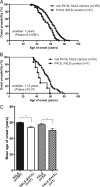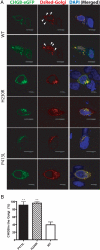Chromogranin B P413L variant as risk factor and modifier of disease onset for amyotrophic lateral sclerosis
- PMID: 20007371
- PMCID: PMC2799865
- DOI: 10.1073/pnas.0902174106
Chromogranin B P413L variant as risk factor and modifier of disease onset for amyotrophic lateral sclerosis
Abstract
Recently, chromogranins were reported to interact specifically with mutant forms of superoxide dismutase that are linked to amyotrophic lateral sclerosis (ALS). This interaction led us to analyze the frequencies of sequence variants of the CHGB gene in ALS patients and matched controls from three different countries. Of particular interest was the finding of the P413L CHGB variant present in 10% of ALS patients (n = 705) as compared to 4.5% in controls (n = 751), conferring a 2.2-fold greater relative risk to develop the disease (P < 0.0001). This effect was mainly contributed by the samples of French origin that yielded a frequency of the P413L variation at 17% in ALS (n = 289) and 5% in controls (n = 448), conferring a 3.3-fold greater risk to develop ALS. Furthermore, the P413L CHGB variant is associated with an earlier age of onset by almost a decade in both sporadic ALS and familial ALS cases. Genetic variation influencing age of onset in ALS had not previously been reported. Expression of fusion CHGB-EGFP constructs in SHSY-5Y cells revealed that the P413L variation can cause defective sorting of CHGB into secretory granules. The finding that CHGB may act as a susceptibility gene and modifier of onset in ALS is consistent with the emerging view that dysfunction of the secretory pathway may contribute to increased vulnerability of motor neurons.
Conflict of interest statement
The authors declare no conflict of interest.
Figures


Comment in
-
P413L CHGB is not associated with ALS susceptibility or age at onset in a Dutch population.Proc Natl Acad Sci U S A. 2010 May 11;107(19):E77; author reply E78. doi: 10.1073/pnas.1002512107. Epub 2010 Apr 29. Proc Natl Acad Sci U S A. 2010. PMID: 20431044 Free PMC article. No abstract available.
References
-
- Tandan R, Bradley WG. Amyotrophic lateral sclerosis: Part 1. Clinical features, pathology, and ethical issues in management. Ann Neurol. 1985;18:271–280. - PubMed
-
- Mulder DW, Kurland LT, Offord KP, Beard CM. Familial adult motor neuron disease: amyotrophic lateral sclerosis. Neurology. 1986;36:511–517. - PubMed
-
- Eisen A, et al. SOD1 gene mutations in ALS patients from British Columbia, Canada: clinical features, neurophysiology and ethical issues in management. Amyotroph Lateral Scler. 2008;9:108–119. - PubMed
-
- Bruijn LI, et al. Aggregation and motor neuron toxicity of an ALS-linked SOD1 mutant independent from wild-type SOD1. Science. 1998;281:1851–1854. - PubMed
Publication types
MeSH terms
Substances
LinkOut - more resources
Full Text Sources
Medical
Miscellaneous

